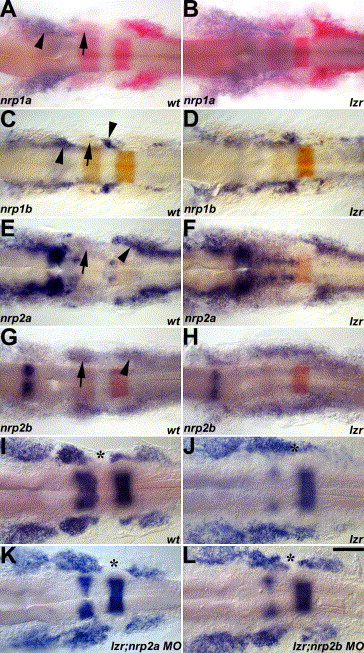Fig. 4
Fig. 4 Zebrafish nrps interact with lzr/pbx4 during cranial NCC migration. nrp expression is shown in blue in A–H; krox20 and dlx2 are in pink or orange in A–H and blue in I–L. Arrows indicate the second cranial NC stream. (A–B) nrp1a is expressed on the first cranial NC stream (arrowhead). (C–D) nrp1b is expressed in a subset of proximal cranial NCCs contributing to the cranial sensory ganglia (arrowheads). (E–H) nrp2a in E-F and nrp2b in G–H are expressed in cranial NCCs. nrp2a is expressed strongly on the first and third cranial NC streams and weakly on the second cranial NC stream, while nrp2b is expressed in all three streams. Arrowheads indicate the third cranial NC stream in E and G. In lzr/pbx4 mutants, nrp expression in the cranial NC is disorganized in a manner corresponding to the disorganization of cranial NCCs. (I–L) MO knockdown of Nrp2a (K) or Nrp2b (L) results in the restoration of the normal cranial NCC migratory pattern. Asterisks mark the cranial NC-free zone in I. K and L and cranial NCCs in this normally cranial NC-free zone in lzr/pbx4 mutants (J). Scale bar: 40 μm in A–L.
Reprinted from Developmental Biology, 280(2), Yu, H.H., and Moens, C.B., Semaphorin signaling guides cranial neural crest cell migration in zebrafish, 373-385, Copyright (2005) with permission from Elsevier. Full text @ Dev. Biol.

